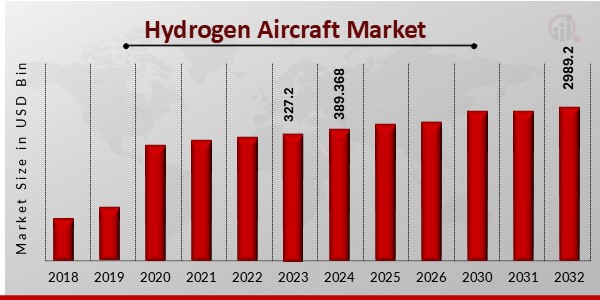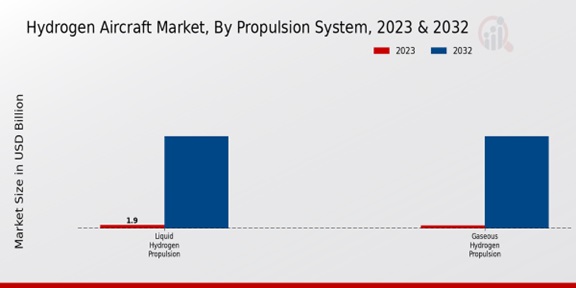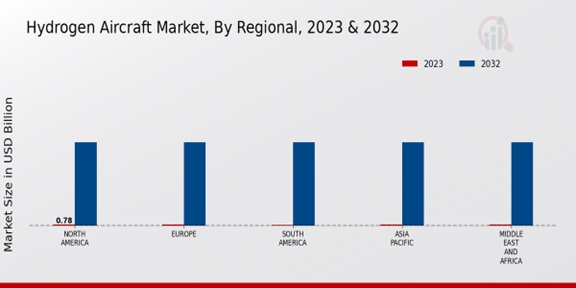Global Hydrogen Aircraft Market Overview
Hydrogen Aircraft Market Size was estimated at USD 327.2 Billion in 2023. The Hydrogen Aircraft Market Industry is expected to grow from USD 389.368 Billion in 2024 to USD 2989.2 Billion by 2032. The Hydrogen Aircraft Market CAGR (growth rate) is expected to be around 29.02 % during the forecast period (2024 - 2032).

Source Primary Research, Secondary Research, MRFR Database and Analyst Review
Key Hydrogen Aircraft Market Trends Highlighted
The demand for sustainable air travel and the urgency to reduce carbon emissions are driving the growth of the hydrogen aircraft market. Governments worldwide have set ambitious decarbonization targets, leading to increased investments in hydrogen-powered technologies. Major aircraft manufacturers are actively pursuing the development of hydrogen-powered aircraft, with several prototypes undergoing testing and certification.
Hydrogen aircraft offer several advantages over conventional jet fuel, including reduced emissions, lower noise levels, and increased energy efficiency. The adoption of hydrogen as a fuel source is expected to contribute to the aviation industry's sustainability goals significantly. The availability of renewable hydrogen production pathways further enhances the environmental benefits of hydrogen aircraft.
Recent trends indicate a growing focus on technological advancements, particularly in fuel cell technology and hydrogen storage systems. Collaboration between aircraft manufacturers, hydrogen producers, and energy companies is essential to ensure the seamless integration of hydrogen infrastructure within the aviation ecosystem. As the technology matures and the infrastructure expands, the market for hydrogen aircraft is anticipated to expand significantly in the coming years.
Hydrogen Aircraft Market Drivers
Growing Environmental Concerns
The aviation industry is one of the most harmful with regard to the greenhouse effect, and while there is an increasing demand for more sustainable ways of traveling long distances, the market for hydrogen aircraft has been growing. The reason for this continuous growth is the strongest when considering the Hydrogen Aircraft Market Industry because flying with hydrogen represents zero emissions. This process is dictated by numerous governments and other companies that are trying to decrease their adverse environmental impact.
Advances in Hydrogen Technology
The development of new hydrogen storage and fuel cell technologies is making hydrogen-powered aircraft more feasible. These technologies are becoming more efficient and cost-effective, which is making hydrogen-powered aircraft a more attractive option for airlines.
Government Support
Governments around the world are providing financial and regulatory support for the development of hydrogen-powered aircraft. This support is helping to accelerate the commercialization of hydrogen-powered aircraft and is a key driver of the growth of the Hydrogen Aircraft Market Industry.
Hydrogen Aircraft Market Segment Insights
Hydrogen Aircraft Market Propulsion System Insights
Given the revenues-based on propulsion systems, the propulsion system segment of the hydrogen aircraft market can be based on two subsegments- liquid hydrogen-based system and gaseous hydrogen system. Throughout the years, the liquid hydrogen-based propulsion system occupied the largest revenue share in 2023.
The liquid hydrogen-based propulsion system is projected to continue its domination within the market due to its higher density of energy for liquid hydrogen formulations than for gaseous hydrogen ones. The density of energy of liquid hydrogen propulsion systems facilitates its storage in the cryogenic state. In turn, such a state implies the temperature minimum for keeping liquid hydrogen is equal to -253C over degrees of Kelvin. Also, such a state is critical to the extent that it requires a cryogenic insulation type to keep the system closed and liquid at all times.
Another fact regarding liquid hydrogen is its elevated energy density compared to gaseous hydrogen, which can store more FCE in a lesser volume. Moreover, the energy density is vital in the conditions that adequate materials are used for the hydrogen containment space. The Gaseous Propulsion System details differently from liquid storage, gaseous hydrogen is kept as such under high pressure involving certain tank strength and controlling mechanism to keep it in the gaseous state. The second main difference is the energy density of liquid hydrogen is decreased in the case of the gaseous states so that the tank has to be bigger. Lastly, it can be concluded that the gaseous hydrogen propulsion system is less costly and of a less complexity level.

Source Primary Research, Secondary Research, MRFR Database and Analyst Review
Hydrogen Aircraft Market Aircraft Type Insights
The Aircraft Type segment in the Hydrogen Aircraft Market is categorized into Passenger Aircraft and Cargo Aircraft. In 2023, the Passenger Aircraft segment dominated the market and accounted for a larger revenue share. Key players in the Hydrogen Aircraft Market are focusing on the development of advanced Passenger Aircraft with increased range and efficiency. For instance, Airbus, a leading aircraft manufacturer, announced its plan to launch its first zero-emission passenger aircraft by 2035. The Cargo Aircraft segment is also projected to experience significant growth in the coming years due to rising demand for efficient and sustainable cargo transportation.
The market is witnessing increased interest from logistics companies and freight forwarders to adopt hydrogen-powered Cargo Aircraft to reduce their carbon footprint. As a result, the Hydrogen Aircraft Market is expected to witness strong growth with increasing investments in research and development activities, government initiatives, and rising consumer awareness about environmental sustainability.
Hydrogen Aircraft Market Power Output Insights
The Power Output segment is a crucial aspect of the Hydrogen Aircraft Market, influencing market growth and industry dynamics. The segment is categorized into three sub-segments Less than 500 kW, 500 kW to 1 MW, and Over 1 MW. In 2023, the Less than 500 kW sub-segment held a significant market share, owing to the increasing demand for smaller, regional aircraft. The 500 kW to 1 MW sub-segment is projected to witness steady growth due to its suitability for mid-range aircraft. This growth is attributed to government initiatives, technological advancements, and rising environmental concerns.
The market segmentation provides valuable insights into the industry, enabling stakeholders to make informed decisions and capitalize on growth opportunities
Hydrogen Aircraft Market Application Insights
The application segment of the Hydrogen Aircraft Market is broadly classified into short-haul flights, medium-haul flights, and long-haul flights. Short-haul flights are expected to dominate the market with a revenue projection of USD 24.91 billion by 2032, owing to the increasing demand for regional air connectivity and the suitability of hydrogen-powered aircraft for shorter distances. Medium-haul flights are anticipated to grow significantly, reaching a market value of USD 18.79 billion by 2032, driven by the rising popularity of point-to-point connections and the need for eco-friendly alternatives in the aviation sector.
Long-haul flights are expected to witness steady growth, with a projected market size of USD 11.21 billion by 2032, as advancements in hydrogen storage and fuel cell technology enable longer flight ranges.
Hydrogen Aircraft Market Regional Insights
The regional landscape of the Hydrogen Aircraft Market exhibits significant variations in terms of market size, growth potential, and competitive dynamics. North America is projected to dominate the market throughout the forecast period, capturing a major share of the Hydrogen Aircraft Market revenue due to the presence of leading aircraft manufacturers, government initiatives, and a robust aviation industry. Europe follows closely behind North America, driven by stringent environmental regulations and a growing focus on sustainable aviation.
The Asia-Pacific (APAC) region is expected to witness the fastest growth over the coming years, owing to the increasing demand for air travel and the presence of emerging economies with ambitious plans for hydrogen-powered aviation. South America and the Middle East Africa (MEA) regions are anticipated to contribute a smaller share to the Hydrogen Aircraft Market, but they present significant growth opportunities due to the increasing awareness of hydrogen aviation and the potential for partnerships with international players.

Source Primary Research, Secondary Research, MRFR Database and Analyst Review
Hydrogen Aircraft Market Key Players And Competitive Insights
Major players in the Hydrogen Aircraft Market make various efforts to gain a competitive advantage. Thus, the leading firms that operate in the Hydrogen Aircraft Market realize that they need to partner with related research and supply institutions to expand their geographic reach. Additionally, the leading firms that operate in the Hydrogen Aircraft Market realize that they need to partner with research institutions and industry participants to gain access to the knowledge and resources that can support their innovative efforts. Clearly, the Hydrogen Aircraft Market is a highly competitive and concentrated industry, which is why the leading companies actively work on developing and testing essential products that meet the demands of the aviation industry.
One of the major competitors in the Hydrogen Aircraft Market is Airbus, a large aerospace firm that has developed a ZEROe concept aircraft and an E-Fan X all-electric test aircraft. The company has also partnered with CFM International and adjusted its Safran partnership to have the ability to use hybrid hydrogen turbines for its testing. Airbus is internationally recognized for its commitment to sustainability, which explains why the firm has successfully positioned itself in the Hydrogen Aircraft Market as a major stakeholder that is determined to reduce carbon emissions through hydrogen aircraft.
The firm's main competitor is Boeing, another American aerospace and aeronautics company that is working on similar efforts to develop hydrogen-powered aircraft for commercial use. The firm has also built relationships with NASA and various other research organizations to develop alternative fuel cells, especially hydrogen mixes that will power future aircraft. The firm's long history and experience in aircraft manufacturing imply that Boeing performs well in the Hydrogen Aircraft Market.
Key Companies in the Hydrogen Aircraft Market Include
- COMAC
- ATR
- Ilyushin
- Bombardier
- Tupolev
- Embraer
- Irkut
- Sukhoi
- Airbus
- Boeing
- Antonov
Hydrogen Aircraft Market Industry Developments
The hydrogen aircraft market is anticipated to witness substantial growth in the coming years, driven by rising concerns over carbon emissions and the increasing adoption of sustainable aviation practices. In 2023, the market size was valued at USD 3.71 billion, and it is projected to reach USD 54.91 billion by 2032, exhibiting a CAGR of 34.91%.
Recent developments in the industry include
In January 2023, Airbus announced plans to launch the world's first zero-emission commercial aircraft by 2035, powered by hydrogen fuel cells.
In March 2023, ZeroAvia completed the world's first hydrogen-powered commercial flight with a six-seater aircraft.
Several governments worldwide are offering incentives and funding to support the development and adoption of hydrogen aircraft technology.
Hydrogen Aircraft Market Segmentation Insights
Hydrogen Aircraft Market Propulsion System Outlook
- Liquid Hydrogen Propulsion
- Gaseous Hydrogen Propulsion
Hydrogen Aircraft Market Aircraft Type Outlook
- Passenger Aircraft
- Cargo Aircraft
Hydrogen Aircraft Market Power Output Outlook
- Less than 500 kW
- 500 kW to 1 MW
- Over 1 MW
Hydrogen Aircraft Market Application Outlook
- Short-haul Flights
- Medium-haul Flights
- Long-haul Flights
Hydrogen Aircraft Market Regional Outlook
-
North America
-
Europe
-
South America
-
Asia-Pacific
-
Middle East and Africa
|
Report Attribute/Metric
|
Details
|
|
Market Size 2023
|
327.2 (USD Billion)
|
|
Market Size 2024
|
389.368 (USD Billion)
|
|
Market Size 2032
|
2989.2 (USD Billion)
|
|
Compound Annual Growth Rate (CAGR)
|
29.02 % (2024 - 2032)
|
|
Report Coverage
|
Revenue Forecast, Competitive Landscape, Growth Factors, and Trends
|
|
Base Year
|
2023
|
|
Market Forecast Period
|
2024 - 2032
|
|
Historical Data
|
2019 - 2022
|
|
Market Forecast Units
|
USD Billion
|
|
Key Companies Profiled
|
COMAC, ATR, Ilyushin, Bombardier, Tupolev, Embraer, Irkut, Sukhoi, Airbus, Boeing, Antonov
|
|
Segments Covered
|
Propulsion System, Aircraft Type, Power Output, Application, Regional
|
|
Key Market Opportunities
|
Growing Environmental Concerns Government Incentives and Support Technological Advancements Rising Fuel Costs Increasing Demand for Sustainable Aviation
|
|
Key Market Dynamics
|
Rising Fuel Costs Government Incentives Technological Advancements Growing Environmental Concerns Partnerships and Collaborations
|
|
Countries Covered
|
North America, Europe, APAC, South America, MEA
|
Frequently Asked Questions (FAQ) :
The hydrogen aircraft market is expected to reach a valuation of USD 327.2 billion in 2023.
The hydrogen aircraft market is projected to reach a valuation of USD 2989.2 billion by 2032, exhibiting a CAGR of 29.02% from 2024 to 2032.
North America and Europe are anticipated to hold significant market shares due to supportive government policies, technological advancements, and the presence of major aircraft manufacturers in these regions.
Hydrogen aircraft are primarily targeted for commercial passenger and cargo transportation, offering potential advantages in reducing carbon emissions and enhancing sustainability in the aviation sector.
Prominent players in the hydrogen aircraft market include Airbus, Boeing, Embraer, and ZeroAvia, among others. These companies are actively involved in developing, testing, and commercializing hydrogen-powered aircraft.
The growing demand for sustainable aviation solutions, government initiatives to reduce carbon emissions, and technological advancements in hydrogen storage and fuel cell systems are key factors propelling the growth of the hydrogen aircraft market.
Challenges faced by the hydrogen aircraft market include the high costs associated with hydrogen production and infrastructure development, as well as the need for regulatory approvals and certification for hydrogen-powered aircraft.
The hydrogen aircraft market is anticipated to witness significant growth in the coming years, driven by increasing investments in research and development, collaborations between industry stakeholders, and supportive government policies aimed at decarbonizing the aviation sector.
Key trends shaping the hydrogen aircraft market include the development of more efficient hydrogen storage systems, advancements in fuel cell technology, and the increasing focus on sustainable aviation practices.
Hydrogen aircraft have the potential to revolutionize the aviation industry by reducing carbon emissions, improving energy efficiency, and enhancing sustainability. They offer a promising solution for long-haul flights and could contribute to the decarbonization of the air transport sector.

















